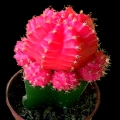
G.
cv. RED HIBOTAN

M. cochal
|
Description:
Myrtillocalycium 'Polyp' is a graft chimera (bigeneric
cactus chimaera) between Myrtillocactus cochal and
Gymnocalycium cv. Red Hibotan, it is a very colourful red
and green columnar cactus This plant is quite unstable and have a
tendency to revert to common red Gymnocalycium shoots.
Chimeras in the the Cactaceae family: Chimaeras
of plants belonging to the Cactaceae
family are very rare and quite unusual in
cultivation. The first chimera + Hylocalycium (Hylocereus
undatus + Gymnocalycium mihanovichii forma rubra
“cv. Red Hibotan”), was described in cactus & succ .J. of
America 1987 61- 4 2,
Recently some other chimerical cactus have
been signalled in internet for example:
- + Myrtillocalycium
(Myrtillocactus geometrizans + Gymonocalycium cv. Red Hibotan
)
- + Myrtillocalycium (Myrtillocactus
cochal + Gymonocalycium cv. Red Hibotan )
- Gymnocalycium
mihanovichii v. fleischerianum + Echinopsis tubiflora.
- Gymnocalycium
mihanovichii v. fleischerianum + Hylocereus guatamalensis
- Ariocarpus retusus
+ Echinopsis eyriesii
|